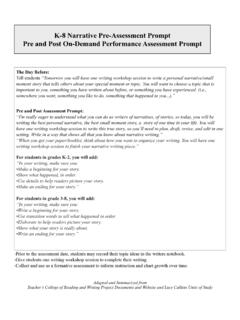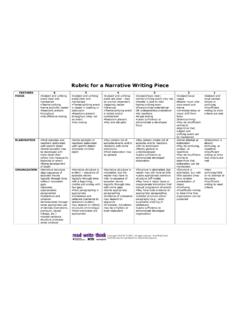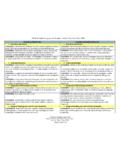Transcription of Rubric for Narrative Writing—Third Grade
1 Name: _____ Date: _____. Rubric for Narrative writing third Grade Grade 1 Grade 2 Grade 3 Grade 4. (1 POINT) PTS (2 POINTS) PTS (3 POINTS) PTS (4 POINTS) SCORE. STRUCTURE. Overall The writer wrote about when Mid- The writer wrote about one Mid- The writer told the story bit Mid- The writer wrote the important she did something. level time when he did something. level by bit. level part of an event bit by bit and took out unimportant parts. Lead The writer tried to make a Mid- The writer thought about how Mid- The writer wrote a beginning Mid- The writer wrote a beginning beginning for his story. level to write a good beginning and level in which he helped readers level in which she showed what was chose a way to start her story.
2 Know who the characters were happening and where, getting She chose the action, talk, or and what the setting was in readers into the world of the setting that would make a his story. story. good beginning. Transitions The writer put her pages in Mid- The writer told the story in Mid- The writer told her story in Mid- The writer showed how much order. She used words such as level order by using words such as level order by using phrases such as level time went by with words and and and then, so. when, then, and after. a little later and after that. phrases that mark time such as just then and suddenly (to show when things happened quickly) or after a while and a little later (to show when a little time passed).
3 Ending The writer found a way to end Mid- The writer chose the action, Mid- The writer chose the action, Mid- The writer wrote an ending his story. level talk, or feeling that would level talk, or feeling that would level that connected to the make a good ending. make a good ending and beginning or the middle of the worked to write it well. story. The writer used action, dialogue, or feeling to bring her story to a close. Organization The writer wrote her story Mid- The writer wrote a lot of lines Mid- The writer used paragraphs Mid- The writer used paragraphs to across three or more pages. level on a page and wrote across a level and skipped lines to separate level separate the different parts or lot of pages.
4 What happened first from what times of the story or to show happened later (and finally) in when a new character was her story. speaking. TOTAL. May be photocopied for classroom use. 2013 by Lucy Calkins and Colleagues from the Teachers College Reading and writing Project from Units of Study in Opinion, Information, and Narrative writing (firsthand: Portsmouth, NH). Grade 1 Grade 2 Grade 3 Grade 4. (1 POINT) PTS (2 POINTS) PTS (3 POINTS) PTS (4 POINTS) SCORE. DEVELOPMENT. Elaboration* The writer put the picture from Mid- The writer tried to bring her Mid- The writer worked to show Mid- The writer added more to the (X2). his mind onto the page. He level characters to life with details, level what happened to (and in) his level heart of her story, including not had details in pictures and talk, and actions.
5 Characters. only actions and dialogue but words. also thoughts and feelings. Craft* The writer used labels and Mid- The writer chose strong words Mid- The writer not only told her Mid- The writer showed why (X 2). words to give details. level that would help readers picture level story, but also wrote it in ways level characters did what they did by his story. that got readers to picture including their thinking. what was happening and that The writer made some parts brought her story to life. of the story go quickly, some slowly. The writer included precise and sometimes sensory details and used figurative language (simile, metaphor, personification) to bring his story to life.
6 The writer used a storytelling voice and conveyed the emotion or tone of his story through description, phrases, dialogue, and thoughts. TOTAL. LANGUAGE CONVENTIONS. Spelling The writer used all he knew Mid- To spell a word, the writer Mid- The writer used what he knew Mid- The writer used what she about words and chunks of level used what she knew about level about spelling patterns to help level knew about word families and words (at, op, it, etc.) to help spelling patterns (tion, er, ly, him spell and edit before he spelling rules to help her spell him spell. etc.). wrote his final draft. and edit. She used the word The writer spelled all the word The writer spelled all of the The writer got help from others wall and dictionaries when wall words right and used the word wall words correctly and to check his spelling and needed.
7 Word wall to help him spell used the word wall to help her punctuation before he wrote other words. figure out how to spell other his final draft. words. * Elaboration and Craft are double-weighted categories: Whatever score a student would get in these categories is worth double the amount of points. For example, if a student exceeds expectations in Elaboration, then that student would receive 8 points instead of 4 points. If a student meets standards in Elaboration, then that student would receive 6 points instead of 3 points. May be photocopied for classroom use. 2013 by Lucy Calkins and Colleagues from the Teachers College Reading and writing Project from Units of Study in Opinion, Information, and Narrative writing (firsthand: Portsmouth, NH).
8 Grade 1 Grade 2 Grade 3 Grade 4. (1 POINT) PTS (2 POINTS) PTS (3 POINTS) PTS (4 POINTS) SCORE. LANGUAGE CONVENTIONS (cont.). Punctuation The writer ended sentences Mid- The writer used quotation Mid- The writer punctuated dialogue Mid- When writing long, complex with punctuation. level marks to show what characters level correctly with commas and level sentences, the writer used The writer used a capital letter said. quotation marks. commas to make them clear for names. When the writer used words While writing , the writer used and correct. The writer used commas in such as can't and don't, he punctuation at the end of dates and lists. used the apostrophe.
9 Every sentence. The writer wrote in ways that helped readers read with expression, reading some parts quickly, some slowly, some parts in one sort of voice and others in another. TOTAL. Teachers, we created these rubrics so you will have your own place to pull together scores of student work. You can use If you want to translate this score into a Grade , you can use the provided table to score each student on a scale of 0 4. these assessments immediately after giving the on-demands and also for self-assessment and setting goals. Number of Points Scaled Score Scoring Guide 1 11 1. In each row, circle the descriptor in the column that matches the student work.
10 Scores in the categories of Elaboration and Craft are worth double the point value (2, 3, 4, 5, 6, 7, or 8 instead of 1, , 2, , 3, , or 4). 17 22 2. Total the number of points and then track students' progress by seeing when the total points increase. Total score: _____. 28 33 3. 39 44 4. May be photocopied for classroom use. 2013 by Lucy Calkins and Colleagues from the Teachers College Reading and writing Project from Units of Study in Opinion, Information, and Narrative writing (firsthand: Portsmouth, NH).



